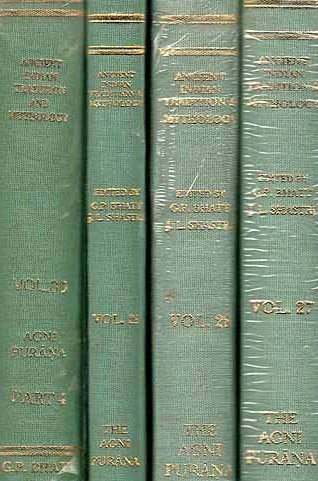The Agni Purana
by N. Gangadharan | 1954 | 360,691 words | ISBN-10: 8120803590 | ISBN-13: 9788120803596
This page describes Description of different continents (maha-dvipa) which is chapter 119 of the English translation of the Agni Purana, one of the eighteen major puranas dealing with all topics concerning ancient Indian culture, tradition and sciences. Containing roughly 15,000 Sanskrit metrical verses, subjects contained in the Agni-Purana include cosmology, philosophy, architecture, iconography, economics, diplomacy, pilgrimage guides, ancient geography, gemology, ayurveda, etc.
Chapter 119 - Description of different continents (mahā-dvīpa)
[Sanskrit text for this chapter is available]
Fire-god said:
1. The Jambūdvīpa extends to a lakh of yojanas. It is surrounded by the Kṣīroda (ocean) measuring one lakh yojanas.
2. The Plakṣadvīpa is surrounded by the Kṣāra ocean. The seven sons of Medhātithi are the rulers of Plakṣadvīpa.
3. They are Śāntabhaya, Śiśira, Sukhodaya, Ānanda, Śiva, Kṣema and Dhruva after whom the countries are named.
4. Gomedha, Candra, Nārada, Dundubhī, Somaka, Sumanā and Vaibhrāja are the boundary mountains. The inhabitants are good.
5. There are seven principal rivers here. The inhabitants from Plakṣa to Śāka live for five thousand years and they adhere to righteous way of life adhering to the institutions of caste and stages of life.
6-7. Āryakas, Kurus, Viviṃśas and Bhāvins are respectively the brahmins and others (kṣatriyas, vaiśyas and śūdras) here. They worship (lord) Soma (moon). Its extent is two lakhs yojanas and it is surrounded by the ocean of ikṣurasa of equal measure. The Śālmala (dvīpa) is twice that. The seven sons of Vapuṣmat were the rulers of Śālmala.
8-12. Śveta, Harita, Jīmūta, Lohita, Vaidyuta, Mānasa and Suprabha are their names and the countries were known by their names. This twice bigger continent is surrounded by the Suroda (ocean) of equal measure. The seven (boundary mountains) are Kumuda, Anala, Balāhaka, Droṇa, Kaṅka, Mahiṣa and Kakudmat. The brahmins and other (three castes) are Kapila, Aruṇa, Pīta and Kṛṣṇa (respectively). They worship (the lord) in the form of Vāyu (wind god). This is surrounded by Suroda. Udbhida, Dhenumat, Dvairatha, Lambana, Dhairya, Kapila and Prabhākara, (the sons) of Jyotiṣmat were the rulers of Kuśa (Kuśadvīpa). Dadhimukhya[1] and others are the brahmins and others. They worship (the lord) in the form of Brahmā.
13. Vidruma, Hemaśaila, Dyutimat, Puṣpavat, Kuśeśaya, Hariśaila and Mandara are the boundary mountains.
14-16. This is surrounded by the Ghṛtoda ocean as well as the Krauñcadvīpa. The sons of Dyutimat were the rulers of Krauñca and the countries (ruled by them) were named after them. They are seven—Kuśala, Manonuga, Uṣṇa, Pradhāna, Andhakāraka, Muni and Dundubhi. (The names of) the seven mountains here are Krauñca, Vāmana, Andhakāraka, Devāvṛt, Puṇḍarīka and Dundubhi. Each one of them is twice as big as the other.
17-19. The mountains in the respective continents are also twice as the corresponding one in the others. The brahmins and others (three castes) are Puṣkara, Puṣkala, Dhanya and Tiṣya and (they) worship Hari. The Krauñcadvīpa is surrounded by Dadhimaṇḍodaka (ocean) and the Śākadvīpa. The sons of Havya and the rulers of Śākadvīpa were Jalada, Kumāra, Sukumāra, Maṇīvaka, Kuśottara, Modākī and Druma. The countries were known by their names.
20-21. Udaya, Jaladhara, Raivata, Śyāma, Kodraka, Āmbikeya and the beautiful Keśarī are the seven (boundary) mountains. The brahmins and others are Maga, Magadha, Mānasa and Mandaga. They worship (the lord) in the form of the Sun. The Śāka dvīpa is surrounded by the Kṣīrābdhi.
22-24. It is also surrounded by Puṣkara (dvīpa). (The ruler of Puṣkara), Savana had two sons—Mahāvīta and Dhātaki. They ruled over two countries known by their name. There is one boundary mountain called Mānasa at the centre in the shape of a bracelet. It extends to one thousand yojanas and is of equal height. (The people here) live for ten thousand years. (Lord) Brahmā is worshipped here by celestials. This continent is surrounded by the Svādūdaka ocean of equal measure.
25-26. The waters of the ocean neither decrease nor increase. O Sage! At the moon-rise or moon-set and at the white and dark fortnights, an increase or decrease of waters by five hundred and ten aṅgulas (equal to one finger-breadth) is seen in the oceans.
27-28. The Svādūdaka is of many good qualities. The land is golden and is devoid of living beings. The peak (called) Lokāloka extends to a lakh of yojanas. It is engulfed in darkness in the form of the pan of the egg-shaped (universe). This land found with this pan of the egg-shaped (universe) extends to fifty crores.
Footnotes and references:
[1]:
These are Daminaḥ [Damina?], Śuṣmiṇaḥ [Śuṣmiṇa?], Snehāḥ [Sneha/Snehā?] and Mandehāḥ [Mandeha/Mandehā?].
